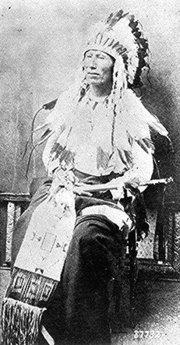Dull
Knife (or Morning Star, as he was called by the Cheyennes)
was not at the Little Bighorn. He was one of the few Northern
Cheyenne Council Chiefs that had remained close to the White
River Agency to show the whites that he wished to remain
at peace. Other Chiefs who stayed at the agency were Turkey
Leg, Standing Elk, Spotted Elk, Living Bear, and Black Bear.
The most important Cheyenne Chief Little Wolf only arrived
shortly after the battle ended.
Most of the other 44 Council Chiefs of the Northern Cheyenne
were at the Little Bighorn at the time of the battle. The
two Old Man Chiefs Old Bear and Black Moccasin (a/k/a Limber
Lance) were regarded as the principal Chiefs. (See Father
Peter Powell: People of the Sacred Mountain.)
In some Indian accounts you can find the name Dull Knife.
Often he is confused with Lame White Man. I guess the other
reason is that Dull Knife's son Bull Hump, often called
Dull Knife himself, was in the battle.
— Dietmar Schulte-Möhring

Apparently
Dull Knife was either unlucky or did not have enough skill
as a leader.
It was his village that was attacked in November 1876 by
the military that broke the back of the Northern Cheyenne.
This after several warriors insisted that the village stay
put and celebrate all night over some minor victory over
other Indians.
It was Dull Knife and Little Wolf that separated the band.
Dull Knife's people were eventually captured and sent to
an army fort and imprisoned in barracks after they refused
to go to another reservation. They broke out of barracks
on a winter night after the military refused them food,
water, and heat only to have most of them shot down. Little
Wolf's band hid out for the winter and eventually surrendered
under better conditions. —
Crzhrs

Dull
Knife was one of the most peace-loving chiefs of the Cheyenne.
He was elected as a council chief in 1854 when he was some
forty-six winters old. Although he was a brave warrior in
his younger days, he by then already possessed the wisdom
of years. He was a strong peace man, who believed that the
Cheyenne and the Whites must get along together.
— Dietmar Schulte-Möhring

I
read in Joe Starita's book about the Dull Knife family that
Chief Dull Knife (or Morning Star by his Cheyenne name)
had one son (Bull Hump, his eldest) and four daughters with
Pawnee Woman, his first wife, who he had stolen once from
the Pawnee.
He had a second wife named Short One (or Slow Woman) who
bore him three sons and three daughters.
So altogether he had four sons and seven daughters, who
were called the “Beautiful People” by the army troops.
His wife Short One, his son Little Hump, and two daughters
were killed on the flight back north in 1879.
His youngest son was George Dull Knife, born in 1875. Because
he was only about three years old in 1879 and too weak to
travel the hard way, he was left behind at the Darlington
agency in Oklahoma with some Cheyenne relatives. He came
to Pine Ridge in 1883 with 300 other Cheyenne and settled
down in Yellow Bear's Oglala camp. Since then George Dull
Knife and his family is rated as Lakota not Cheyenne. —
Dietmar Schulte-Möhring

This
is often said to be a photo of Dull Knife. Perhaps it's
Buffalo Hump, his son:
 —
Grahame Wood
—
Grahame Wood

The following publications contain information about Dull Knife:
Article: "Death Trail of the Cheyenne" by James Long • Real West • Vol. VII, No. 37 • September 1964.
Article: "Outrage at Oberlin" by Fred Kiewit • Frontier Times • Vol. 39, No. 5, New Series No. 37 • August-September 1965.